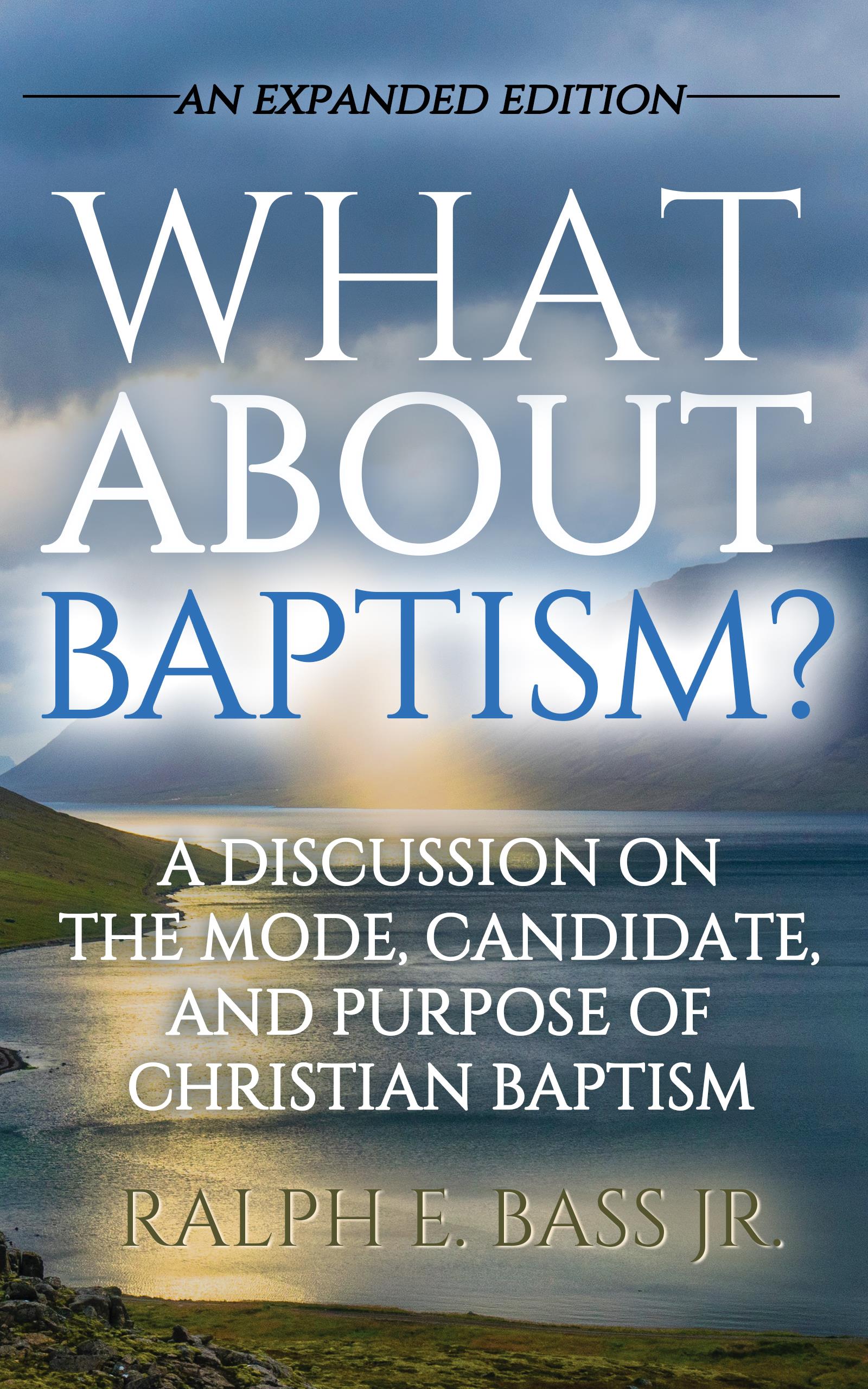
Hi, My Name Is Ralph Bass...This Is My Library


Subscribe to this Site
Baptism Replaces Circumcision
descendants after you: every male among you shall be circumcised…. Any uncircumcised male, who has not been circumcised in the flesh, will be cut off from his people; he has broken my covenant.” Genesis 17:10, 14
“So then, those who had received his word were baptized; and there were added that day about three thousand souls.” Acts 2:41
“In reply Jesus declared, ‘I tell you the truth, no one can see the kingdom of God unless he is born again. How can a man be born when he is old?’ Nicodemus asked. ‘Surely he cannot enter a second time into his mother’s womb to be born!’ Jesus answered, ‘I tell you the truth, no one can enter the kingdom of God unless he is born of water and the Spirit.’” John 3:3-5
“Circumcision was a token of visible membership in the family of God, and of covenant obligation to him. So is baptism. Circumcision was the ordinance which marked, or publicly ratified, entrance into that visible family. So does baptism. Circumcision was an emblem of moral cleansing and purity. So is baptism. ? Surely then, there is the best foundation for asserting that baptism has come in place of circumcision. The latter?has been discontinued; and now baptism occupies the same place, means the same thing, seals the same covenant, and is a pledge of the same spiritual blessings.”[1]
Let's Look Inside
the Book


Sadly, the relationship between infant circumcision and baptism is almost without understanding by most Christians in our day. Why? This is so simply because there is a preconceived opinion by many that baptism MUST be of adults only. The fact that the circumcision / baptism relationship destroys that image of who is a proper candidate in itself demands that this Old Testament—New Testament continuity must be denied, or better yet, simply not even discussed. But we will discuss it.
Infant Circumcision - The Purpose Of Both Was The Same
The purpose of infant circumcision and baptism is to identify sharers in the Covenant, and to receive new members into the community of faith. Both the Old Testament and the New Testament make these points.
“This is My covenant, which you shall keep, between Me and you and your
Infant Circumcision - The Purpose Of Both Was The Same
The purpose of infant circumcision and baptism is to identify sharers in the Covenant, and to receive new members into the community of faith. Both the Old Testament and the New Testament make these points.
“This is My covenant, which you shall keep, between Me and you and your
“Infant Circumcision - Their Symbolic Teaching Is The Same
The symbols stress the need to cleanse the flesh from sin. Unchanged is the condition of the human heart through the ages. Unchanged is the need to put off the old man and be cleansed from sin.
“Circumcise your hearts, therefore, and do not be stiff-necked any longer.” Deuteronomy 10:16
“…and in Him you were also circumcised with a circumcision made without hands, in the removal of the body of the flesh by the circumcision of Christ, having been buried with Him in baptism….” Colossians 2:11-12
“And now what are you waiting for? Get up, be baptized and wash your sins away, calling on his name.” Acts 22:16
True “…circumcision is circumcision of the heart, by the Spirit….” Romans 2:29
As the Old Testament rite of initiation symbolically cut away the filth of the flesh of the old nature, so the New Testament rite of initiation symbolically washes away sin.
Infant Circumcision - Both Represent The Work Of The Holy Spirit
It was the Holy Spirit that was active in the hearts of men circumcising them in the Old Testament, washing them in the New Testament.
“But he is a Jew who is one inwardly; and circumcision is that which is of the heart, by the Spirit….” Romans 2:29
“…for we are thetrue circumcision, who worship in the Spirit of God….” Philippians 3:1
“I baptized you with water; but He will baptize you with the Holy Spirit.” Mark 1:8
Infant Circumcision - Both Rites Represent The Same Spiritual Grace: Regeneration
In the Old Testament, circumcision of the flesh was man’s work; circumcision of the heart was God’s work. So it is with water baptism in the New Testament, which is man’s work, whereas the baptism of the Holy Spirit (of the heart) is God’s work.
“Moreover the Lord your God will circumcise your heart and the heart of your descendants….” Deuteronomy 30:6
“He saved us, not on the basis of deeds which we have done in righteousness, but according to His mercy, by the washing of regeneration and renewing by the Holy Spirit, whom He poured out upon us richly through Jesus Christ our Savior….” Titus 3:5-6
Infant Circumcision - Baptism Is Said To Replace Circumcision
There is no mystery here; we are clearly instructed that we, the Church, are the inheritors of Old Testament infant circumcision through our baptism.
“For it is we who are the circumcision, we who worship by the Spirit of God, who glory in Christ Jesus….” Philippians 3:3
“…and in Him you were also circumcised with a circumcision made without hands, in the removal of the body of the flesh by the circumcision of Christ; having been buried with Him in baptism, in which you were also raised up with Him through faith in the working of God, who raised Him from the dead. When you were dead in your sins and in the uncircumcision of your sinful nature, God made you alive with Christ. He forgave us all our sins,having canceled the written code, with its regulations, that was against us and that stood opposed to us; he took it away, nailing it to the cross.” Colossians 2:11-14
Christians are here clearly identified as “circumcised with a circumcision.” Yet, this circumcision was not one done with “hands” or by men but by God. In God’s circumcision, He removed “the body of the flesh.” This occurred when the believer was baptized, not with “hands” but by the Holy Spirit. In this baptism we, as believers, were placed in Christ. Therefore, where Christ went, we went: to Calvary, to the grave, and in resurrection.
This passage does not say that the baptism of the Holy Spirit provides an illustration of a death, burial, and resurrection, which it does not. Instead, “’the putting off of the body of the flesh’ is the same thing as being buried and raised with him in baptism through faith…. …the only conclusion we can reach is that the two signs, as outward rites, symbolize the same inner reality in Paul’s thinking. Thus infant circumcision may fairly be said to be the Old Testament counterpart of Christian baptism.” [2]
This verse is a powerful voice for the equation of infant circumcision and baptism. So much so that the Baptist author Paul King Jewett states, “…the only conclusion we can reach is that the two signs (circumcision and baptism), as outward rites, symbolize the same inner reality in Paul’s thinking.”[3]
The theologian Robert Reymond very ably summarizes this point by saying, “By the authority of Christ and his apostles, the church in this age administers baptism in lieu of circumcision. But it does so with the understanding that the spiritual significance of baptism as a sign is essentially the same as the former Old Testament ceremony, namely, a covenantal sign of the Spirit’s act of cleansing from sin’s defilement.”[4]
Infant Circumcision - The Early Church Replaced Circumcision With Baptism
Justin Martyr, writing in about 150 AD in his Dialogue with Trypho the Jew, says this: “Nor do we receive that useless baptism of cisterns [dipping], for it has nothing to do with this baptism of life. Wherefore also God has announced that you have forsaken Him, the living fountain, and digged for yourselves broken cisterns which can hold no water. Even you, who are the circumcised according to the flesh, have need of our circumcision; but we, having the latter, do not require the former.”[5]
Notice that Justin Martyr equates the circumcision of the Old Testament with Christian baptism. This is a definitive statement and is proof positive that believers in the early church saw baptism as a Christian counterpart for Old Testament circumcision.
Notice that Justin Martyr had no use for baptisms in cisterns. Cisterns were large tanks of rainwater of adequate size to dip large objects—like people for instance. The Jews did have extra biblical dippings as a part of their increasingly heretical methods of worship. Justin Martyr rejects them and identifies the Christian community as inheritors of Old Testament circumcision and calls it this baptism of life.
To make the point again, baptism is unequivocally equated with circumcision. The one replaces the other.
-----------------------------------------------------------------
[1] Miller, Samuel, pg. 13-14.
[2] Ward, Rowland S., pg. 34.
[3] Jewett, Paul King, Infant Baptism and the Covenant of Grace, Eerdmans, Grand Rapids, MI, 1978, pg. 89.
[4] Reymond, Robert L., A New Systematic Theology of the Christian Faith, Thomas Nelson Publishers, Nashville, TN, 1998, pg. 929-930.
[5] Roberts, Alexander, and James Donaldson, Ante-Nicene Fathers: Volume I, Dialogue of Justin Martyr to Trypho, a Jew, Chapter XIX, (Oak Harbor, WA: Logos Research Systems, Inc.) 1997.
















































































































